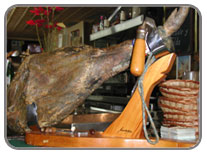
Spanish culture is widely known for Flamenco music and dance, bullfights, fantastic beachesand lots of sunshine. But what is Spain known for? It has much more to offer than that. It is - and has been for thousands of years, one of the cultural centers of Europe.
"Spain is different!", Spaniards use to say. They don't specify compared to what: to the rest of Europe, to the rest of the world, or even to itself? We don't know either, but we do our best to supply you with lots of information about Spain´s culture so you can find the answer to this question and many others by yourself.
Spain has an extraordinary artistic heritage. The dominant figures of the Golden Age were the Toledo-based artists El Greco and Diego Velázquez. Francisco de Goya emerged in the 18th century as Spain's most prolific painter and he produced some wonderfully unflattering portraits of royalty. The art world in the early 20th century was influenced by a remarkable group of Spanish artists: Pablo Picasso, Juan Gris, Joan Miró and Salvador Dalí, ambassadors of the artistic culture in Spain.
Spain's architecture ranges from prehistoric monuments in Minorca in the Balearic Islands, to the Roman ruins of Merida and Tarragona, the decorative Lonja in Seville, Mudéjar buildings, Gothic cathedrals, castles, fantastic modernist monuments and Gaudí's intricate fabulist sculptures in Barcelona. They are all representative of the culture of Spain.
Another example of Spanish culture is the invention of the Spanish guitar, which was invented in Andalusia in the 1790's when a sixth string was added to the Moorish lute. It gained its modern shape in the 1870's. Spanish musicians have taken the humble guitar to dizzying heights of virtuosity and none more so than Andrés Segovia (1893-1997), who established classical guitar as a genre. Flamenco, music rooted in the cante jondo (deep song) of thegitanos (gypsies) of Andalusia, is experiencing a revival. Paco de Lucia is the best knownflamenco guitarist internationally.
His friend Camarón de la Isla was, until his death in 1992, the leading light of contemporarycante jondo. In the 1980s flamenco-rock fusion (a.k.a. "gypsy rock") was developed by the likes of Pata Negra and Ketama, and in the 1990s Radio Tarifa emerged with a mesmerizing mix of flamenco and medieval sounds.

Food
Eating out in Spain is relatively cheap and meals are usually substantial instead of gourmet. The Spanish tradition of tapas is a good way to sample the local food. Tapas are small dishes of snacks which are served anytime especially in small bars. They cover all types of foods from seafood to vegetables. Many Spanish people make an evening of hopping from bar to bar trying different tapas. Another of Spain's favourites is Serrano Ham. Spain is famous for its fish delicacies and simply must be sampled, especially if you get to coastal areas. Paella has long been a Spanish favourite, based on either meat or seafood. Every region in Spain has its own specialities. See Spanish recipes here
Teenage girls tend to wear trousers more than skirts. Denim is definitely 'in'. Teenage boys are keen on designer wear and appearance is important to them. Mature Spaniards dress conservatively and with style. Older men in particular tend to wear high quality clothing.
It is unclear what the Spanish think of scantily clad holiday-makers but it is not acceptable in small villages, away from the coast. One should be particularly careful of dress code if entering churches. Swim-wear and short skirts are frowned upon.
IThe name España is of uncertain origin; from it derived the Hispania of the roman Empire. Important regions within the modern nation are the Basque Country (País Vasco), the Catalan-Valencian-Balearic area, and Galicia—each of which has its own language and a strong regional identity. Others are Andalucía and the Canary Islands; Aragón; Asturias; Castile; Extremadura; León; Murcia; and Navarra, whose regional identities are strong but whose language, if in some places dialectic, is mutually intelligible with the official Castilian Spanish. The national territory is divided into fifty provinces, which date from 1833 and are grouped into seventeen autonomous regions, or comunidades autónomas. Spain occupies about 85 percent of the Iberian peninsula, with Portugal on its western border. Other entities in Iberia are the Principality of Andorra in the Pyrenees and Gibraltar, which is under British sovereignty and is located on the south coast. The Pyrenees range separates Spain from France. The Atlantic Ocean washes Spain's north coast, the far northwest corner adjacent to Portugal, and the far southwestern zone between the Portuguese border and the Strait of Gibraltar. Spain is separated from North Africa on the south by the Strait of Gibraltar and the Mediterranean Sea, which also washes Spain's entire east coast. The Balearic Islands lie in the Mediterranean and the Canary Islands in the Atlantic, off the coast of Africa. Spain also holds two cities, Ceuta and Melilla, on the Mediterranean coast of Morocco. Spain's perimeter is mountainous, the mountains generally rising from relatively narrow coastal plains. The country's interior, while transected by various mountain ranges, is high plateau, or meseta, generally divided into the northern and southern mesetas.
The 'Tomatina' Tomato Fight

The festival on the last Wednesday of August is called 'the Tomatina' and is basically a town-wide tomato fight. It is thought the tradition began in 1945 when a fight erupted among two young members of a carnival crowd. A vegetable stall was nearby in the town square and every started throwing tomatoes at each other. Exactly one year later, young people met at the square, but this time with their own tomatoes. Another food-fight started but was broken up by police.
In the following years this practice was banned by the authorities, but due to popular demand was given official recognition in 1959. This was only to occur if participants would respect the start and the end of tomato-throwing being announced with a banger.

No comments:
Post a Comment